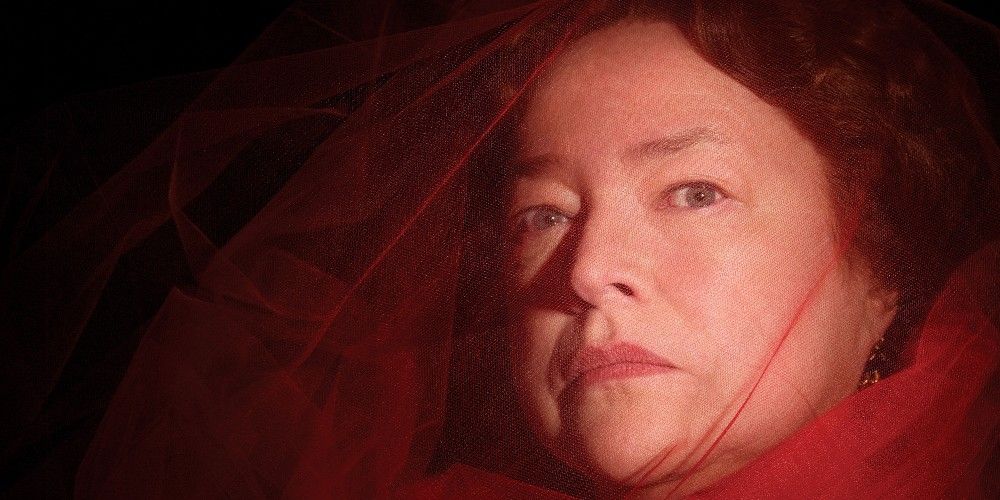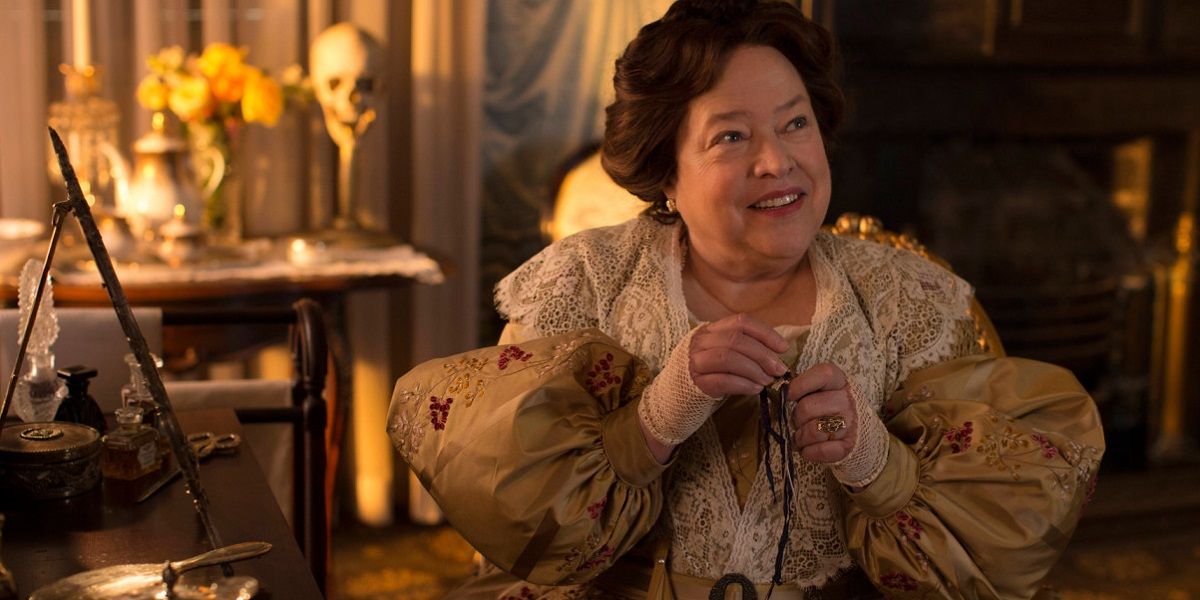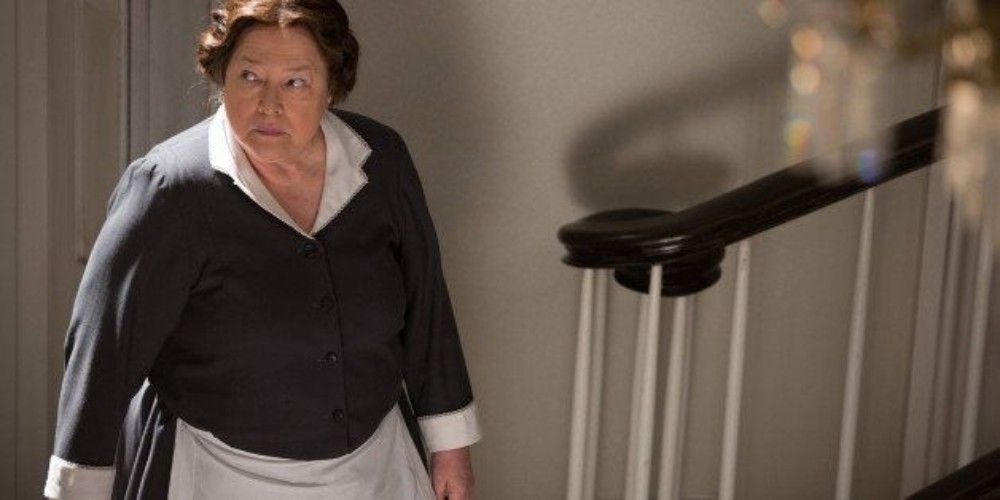As the story goes, veteran character actress Kathy Bates was so impressed with Season 1 and 2 of American Horror Story that she asked Jessica Lange if she’d whisper in Ryan Murphy’s ear about writing in a little part for her in Season 3. That “little part” became Madam Delphine LaLaurie, one of the most sadistic monsters that has ever been featured in the hit anthology series. The role dominated Coven, in a season full of top performances by Jessica Lange and Angela Bassett, and became a shining example of Bates’ enormous talent with its complexity.
Bates has always elevated any film she’s been in, but her penchant for playing psychologically disturbed characters like in Stephen King’s Misery (for which she won her Academy Award for Best Actress) make her perfect for horror. While she’s gone on to collaborate with Murphy as several characters in other seasons of American Horror Story, her Emmy Award-winning performance as Madam LaLaurie is still the grand dam. Here’s 10 reasons why Delphine LaLaurie is her best role.
SHE WAS A REAL PERSON

The horror surrounding the character of Madam Delphine LaLaurie comes from the fact that she actually existed. The real Madam LaLaurie was a socialite in New Orleans with a penchant for torturing her slaves. Such accounts of the atrocities range from chaining her 70 year old cook to the oven, to keeping parts of her house specifically for the most gruesome mutilation.
LaLaurie was never convicted of her crimes, and fled the United States for Europe before she could be apprehended, though an angry mob burned down her plantation. When a later excavation of the grounds was done by authorities, they unearthed 60 or 70 bodies of slaves that had been disposed of to hide the evidence of her sadism.
THE CHARACTER LAUNCHED HER COMEBACK

Kathy Bates is a powerhouse actress, especially when it comes to complex and damaged characters. Beginning with her Academy Award win for Best Actress in Misery, she’s consistently proven that the more wild the role, the more Bates’ talent is guaranteed to shine.
Prior to Coven, Bates had had something of a television renaissance with Two and Half Men (for which she received an Emmy Award for Outstanding Guest Actress in a Comedy) and Harry’s Law, but she hadn’t been given the same meaty parts that earned her such notoriety like Dolores Claiborne and Midnight in Paris. Coven saw her return to form, and she took home the Emmy Award for Outstanding Supporting Actress in a Miniseries for Madam LaLaurie in 2014.
SHE HAD TO CHALLENGE HERSELF

Playing a character like Madam LaLaurie was difficult for Bates. It required her to get inside the mind of a racist and a sadist, where she was forced to understand why her character behaved the way she did. Other roles she’s played, such as in Season 4 and 5 of the series have been much more sympathetic and therefore less emotionally demanding.
LaLaurie was a deplorable person, and what made her such a great villain is that she can be found everywhere. That she existed in New Orleans high society only made her able to get away with her crimes in the past. Kathy Bates proved real villainy wears many masks and many faces, often hiding in plain sight.
SHE WAS TRULY MANIACAL

Madam LaLaurie was not only cruel and sadistic to her slaves, she also seemed to take great delight in torturing her daughters. Whether it was somewhat benign, like frightening their suitors at the Hallow’s Eve Ball, or locking them in cages and force-feeding them feces, her version of a mother’s love was insane.
Bates seemed to relish her moments of pure mania. She expresses no remorse for what she does to her slaves or to her daughters. She views both as ugly and undeserving of real love and affection, to be treated like animals. She’s so deranged, she even makes beauty cream from the pancreas of her husband’s lover’s baby.
SHE HAD MOMENTS OF HUMOR

Madam LaLaurie was nothing if not able to make herself laugh. She constantly made quips when she was at the height of her influence in 19th century New Orleans, and used her sarcastic sense of humor to the detriment of her daughter’s social anxiety.
She enjoyed nothing more than the horror “on a handsome man’s face”, and often took them into her “house of horrors” to make them jump and scream at the assorted body parts she kept under silver dishes. Why? Because it “made her feel young”. And when her conniving daughter wouldn’t fit in her cage? She explained to the slaves, “Break a leg if you have to”.
SHE COULD BE KIND

There’s a scene in Season 3 that no one saw coming. Queenie and Delphine go through a fast food drive-thru and order super-sized combo meals, happily chowing down in the parking lot. They share some banter, and Queenie reveals that she never expected to break bread with an “immortal racist” while being a witch-in-training.
Delphine explains that her sisters will never truly accept her, not because she’s larger than them, but because of her race. Whether or not it’s true, Delphine says it in a compassionate way, and her tone seems to convey that she’s actually trying to give the girl advice in her own roundabout way.
IT WAS COMPLEX

While Madam Delphine lived, she may not have considered the ramifications of her actions, but after she was buried alive and resurrected in an era long after slaves had been emancipated, she was forced to confront her racism throughout the season.
Bates had the Herculean task of trying to find ways to empathize with the monster of Madam LaLaurie, enough so that the audience could sympathize with her (her husband had committed adultery with a house slave). She found the humor and humanity in the part, if only to bring out its complexity. Some viewers thought Delphine could have “come around” from her racist ideologies given time, while others believe she would never have changed, and that’s a credit to Bates’ acting talent.
HER FABULOUS COSTUMES

Without a doubt one of the highlights of Coven were its gorgeous costumes, from the modern day “pilgrim chic” look of the witches, to the opulent 19th century ensembles that Madam LaLaurie wore. Her modern attire as a maid wasn’t as extravagant of course, but it helped convey her character development.
Other than Myrtle and her various eccentric outfits, Kathy Bates got to don some of the most arresting clothes, from beautiful corsets to enormous mutton sleeves. And to top it off, the most exquisite jewelry and fasteners, all of which concealed the horrible ugliness of her soul.
IT WAS THE ONLY TIME SHE ACTED OPPOSITE JESSICA LANGE AND ANGELA BASSETT

Coven was the first appearance for Kathy Bates in American Horror Story. She would go on to have a role in the next season Freak Show, the following season Hotel, as well as Roanoke (she wouldn’t be seen again until Season 8). Season 3 was the only time she got to act with both Jessica Lange and Angela Bassett.
Lange appeared in Freak Show while Bassett did not, and Bassett appeared in Hotel while Lange did not. Bates has always said to act alongside two stage-trained actresses of their caliber was nerve-wracking, but also exhilarating, as she had to bring her A-game every time.
SHE GOT A LARGE CHARACTER ARC

Madam LaLaurie is one of the most interesting characters in Coven, among many eccentric players. By jumping back and forth in time from the modern day, where she is lost in a sea of the anachronisms from another century, and the past, where she was at the height of her power, a large character arc emerges.
We see her come from Paris “the jewel of civilization” to New Orleans, where she finds her inspiration and “muse” by torturing slaves. We then see her humiliated and humbled in servitude to Fiona Goode and several people of color, including Queenie and Marie Laveau. Her character is in constant flux, and her reactions are what make for the most dramatic storytelling.



